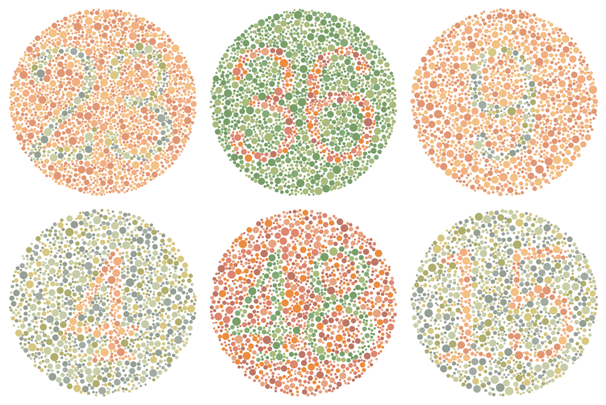Simply said, color blindness is the inability to see or distinguish between colors like blue, green, and red. Rarely, a person will be unable to perceive or distinguish any colors at all. A person with this disease also has trouble telling different colors and hues apart. This condition is often known as a color vision disorder or difficulty.
In the year 1798, an English scientist by the name of John Dalton made the discovery of color blindness. In addition, he was colorblind at the time of the finding. His first article, which was based on his personal experience, was about color blindness. In honor of its discoverer, John Dalton, color blindness is sometimes known as Daltonism.
Types of color blindness
Depending on what kinds of cones aren’t functioning properly, there are several types of color blindness. Knowing a little about cones is helpful for comprehending the many types of color blindness.
Your eye has cones, which are nerve cells that recognize colors in the visible range of light. There are all the wavelengths that people can see in this spectrum. These have a length range of 380 nm for the short ones and 700 nm for the long ones. You typically have three different kinds of cones at birth:
- Long wavelengths (around 560 nanometers) are perceived by red-sensing cones (L cones).
- M cones, or green-sensing cones, are cones that detect medium wavelengths (around 530 nanometers).
- S cones, or blue-sensing cones, are cones that can detect light with short wavelengths (around 420 nanometers).
All three forms of cones are common, and they function as they should. However, at least one sort of cone is malfunctioning if you have a color vision deficit. Cone issues impair your ability to perceive colors in a conventional way. The following general categories define the variety of cones you have and how effectively they’re functioning:
Trichromacy: The presence and proper operation of all three kinds of cones. In the conventional sense, you can see every color present in the visible spectrum of light. This is vision in its entirety.
Dichromacy: An absence of one kind of cone. There are only two sorts of cones, which are often S cones and either L cones or M cones. Through the wavelengths that those two varieties of cones can detect, you can see the world. It is challenging to distinguish between fully saturated hues. These varieties of color blindness are identified by names that end in “anopia” (which denotes a lack of color vision).
Monochromacy: Either there is only one kind of cone present, or there is no cone function at all. You either have very poor color vision or none at all. Instead, you see that everything is colored a variety of gray.
Symptoms
You might not be aware that you have a color vision impairment. When the disease causes confusion, such as when there are issues deciphering color-coded learning materials or discerning the colors in a traffic light, some people realize that they or their child has the condition.
People with color blindness might not be able to tell apart:
- Various red and green tones
- Many hues of yellow and blue
- Every color
The inability to perceive some colours of red and green is the most prevalent color blindness. A person with a red-green or blue-yellow deficiency is frequently not entirely blind to both colors. Defects might range from minor to severe.
Causes
The intricate process of seeing colors across the light spectrum starts with your eyes’ capacity to react to various light wavelengths.
All color wavelengths of light enter your eye through the cornea, travel through the lens and transparent, jelly-like tissue in your eye (vitreous humor), and then arrive to wavelength-sensitive cells (cones) in the macular region of the retina at the back of your eye. Short (blue), medium (green), and long (red) light wavelengths all affect how sensitive the cones are. When certain chemicals in the cones react, your optic nerve transmits the wavelength information to your brain.
You can see color if your eyes are healthy. However, you won’t be able to tell the difference between the colors red, green, or blue if your cones are missing one or more wavelength-sensitive molecules.
There are numerous reasons of color blindness:
Disorder inherited. Males than females are far more likely to have inherited color deficits. Red-green insufficiency is the most frequent color deficit, while blue-yellow deficiency is far less frequent. It is uncommon to be completely color blind.
A mild, moderate, or severe form of the condition can be inherited. Both of your eyes are often affected by inherited color impairments, and the severity doesn’t change over time.
Diseases. Sickle cell anemia, diabetes, macular degeneration, Alzheimer’s disease, multiple sclerosis, glaucoma, Parkinson’s disease, persistent alcoholism, and leukemia are a few illnesses that can result in color impairments. One eye may be more impacted than the other, and if the underlying condition can be treated, the color deficit may improve.
Certain medicines. Some pharmaceuticals, including those used to treat some autoimmune diseases, heart conditions, high blood pressure, erectile dysfunction, infections, neurological disorders, and psychiatric issues, can affect how you see color.
Aging. As you get older, your capacity for color vision slowly declines.
Chemicals. Loss of color vision may result from exposure to certain substances at work, such as carbon disulfide and fertilizers.
What medical procedures can reverse color blindness?
For persons with hereditary color blindness, there is currently no medical cure or treatment available. Your healthcare professional will treat the underlying illness or change your medications as necessary if you have acquired color blindness. Your color vision might be enhanced by doing this.
You may be familiar with spectacles for color blindness. For those who have milder kinds of anomalous trichromacy, these glasses might offer a more vibrant color experience. People with color vision deficiencies can notice the variations between colors more clearly thanks to the glasses’ improved color contrast. However, they don’t let you see any new colors, and the outcomes differ from person to person. It’s vital to understand that these glasses are not a treatment and won’t make your cones work better.
If you’re thinking about getting color-blindness glasses, consult an eye doctor first to find out if they’ll help.




























